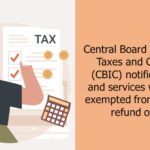Central Board of Indirect Taxes and Customs (CBIC) has issued Circular No. 79/53/2018 dated 31st December, 2018 to clarify certain refund related issues.
The Key points of the Circular are:
- Physical submission of refund claims with jurisdictional proper officer:
In order to simplify the refund process, the following instructions are issued:
- All documents/undertaking/statements to be submitted along with the claim for refund in FORM GST RFD-01A shall be uploaded on the common portal at the time of filing of the refund application. Instead of providing copies of all invoices, a statement of invoices needs to be submitted in a prescribed format and copies of only those invoices need to be submitted the details of which are not found in FORM GSTR-2A for the relevant period. It is now been clarified that the said statement and these invoices, instead of being submitted physically, shall be electronically uploaded on the common portal at the time of filing the claim of refund in FORM GST RFD-01A. Neither the application in FORM GST RFD-01A, nor any of the supporting documents, shall be required to be submitted physically in the office of the jurisdictional proper officer.
- However, the taxpayer will still have the option to physically submit the refund application to the jurisdictional proper officer in FORM GST RFD-01A, along with supporting documents, if he so chooses. A taxpayer who still remains unallocated to the Central or State Tax Authority will necessarily have to submit the refund application physically.
- The ARN will be generated only after the claimant has completed the process of filing the refund application in FORM GST RFD-01A, and has completed uploading of all the supporting documents/undertaking/statements/invoices and, where required, the amount has been debited from the electronic credit/cash ledger
- Calculation of refund amount for claims of refund of accumulated Input Tax Credit (ITC) on account of inverted duty structure:
Refund of unutilized ITC in case of inverted tax structure, is available where ITC remains unutilized even after setting off of available ITC for the payment of output tax liability. Where there are multiple inputs attracting different rates of tax, in the formula provided in rule 89(5) of the CGST Rules, the term „Net ITC‟ covers the ITC availed on all inputs in the relevant period, irrespective of their rate of tax.
- Non-consideration of ITC of GST paid on invoices of earlier tax period availed in subsequent tax period:
It has been clarified that “Net ITC‟ as defined in rule 89(4) of the CGST Rules means input tax credit availed on inputs and input services during the relevant period. Relevant period means the period for which the refund claim has been filed. Input tax credit can be said to have been „availed‟ when it is entered into the electronic credit ledger of the registered person. Under the current dispensation, this happens when the said taxable person files his/her monthly return in FORM GSTR-3B. Further ITC may be claimed on or before the due date of filing of the return for the month of September following the financial year to which the invoice pertains or the date of filing of annual return, whichever is earlier. Therefore, the input tax credit of invoices issued in August, 2017, “availed‟ in September, 2017 cannot be excluded from the calculation of the refund amount for the month of September, 2017.
- Misinterpretation of the meaning of the term “inputs”:
It is clarified that the input tax credit of the GST paid on inputs shall be available to a registered person as long as he/she uses or intends to use such inputs for the purposes of his/her business and there is no specific restriction on the availment of such ITC anywhere else in the GST Act. The GST paid on inward supplies of stores and spares, packing materials etc. shall be available as ITC as long as these inputs are used for the purpose of the business and/or for effecting taxable supplies, including zero-rated supplies, and the ITC for such inputs is not restricted under section 17(5) of the CGST Act. Further, capital goods have been clearly defined in section 2(19) of the CGST Act as goods whose value has been capitalized in the books of account and which are used or intended to be used in the course or furtherance of business. Stores and spares, the expenditure on which has been charged as a revenue expense in the books of account, cannot be held to be capital goods.
- Refund of accumulated ITC of input services and capital goods arising on account of inverted duty structure:
It has been clarified that GST law and the related rules clearly prevent the refund of tax paid on input services and capital goods as part of refund of input tax credit accumulated on account of inverted duty structure.
For further information please refer the attached document.
Source: Central Board of Indirect Taxes & Customs




